Light Rail Network Project Report: System Design and Analysis
VerifiedAdded on 2020/03/16
|17
|3785
|102
Report
AI Summary
This report provides a comprehensive overview of a light rail network project, detailing the various stages of design, development, and implementation. It begins with an executive summary and table of contents, followed by an introduction that highlights the importance of preliminary engineering and planning for successful light rail implementation. The report then delves into the conceptual design phase, covering planning and urban design, station area design concepts, project budget, and schedule. Subsequent sections focus on the preliminary design of the light rail network, including design criteria and operational plans. The design and development segment explores track design, storage tracks, track work (direct fixation and ballasted track), track materials, drainage systems, and traffic management. The report concludes with a discussion on system testing, evaluation, validation, optimization, and human factor incidents, emphasizing the importance of testing phases like factory acceptance, site installation, and performance testing to ensure system readiness. References are provided at the end of the report.

Running head: Light Rail Network Project Report 1
Light Rail Network Project Report
Name
Affiliate Institution
Light Rail Network Project Report
Name
Affiliate Institution
Paraphrase This Document
Need a fresh take? Get an instant paraphrase of this document with our AI Paraphraser
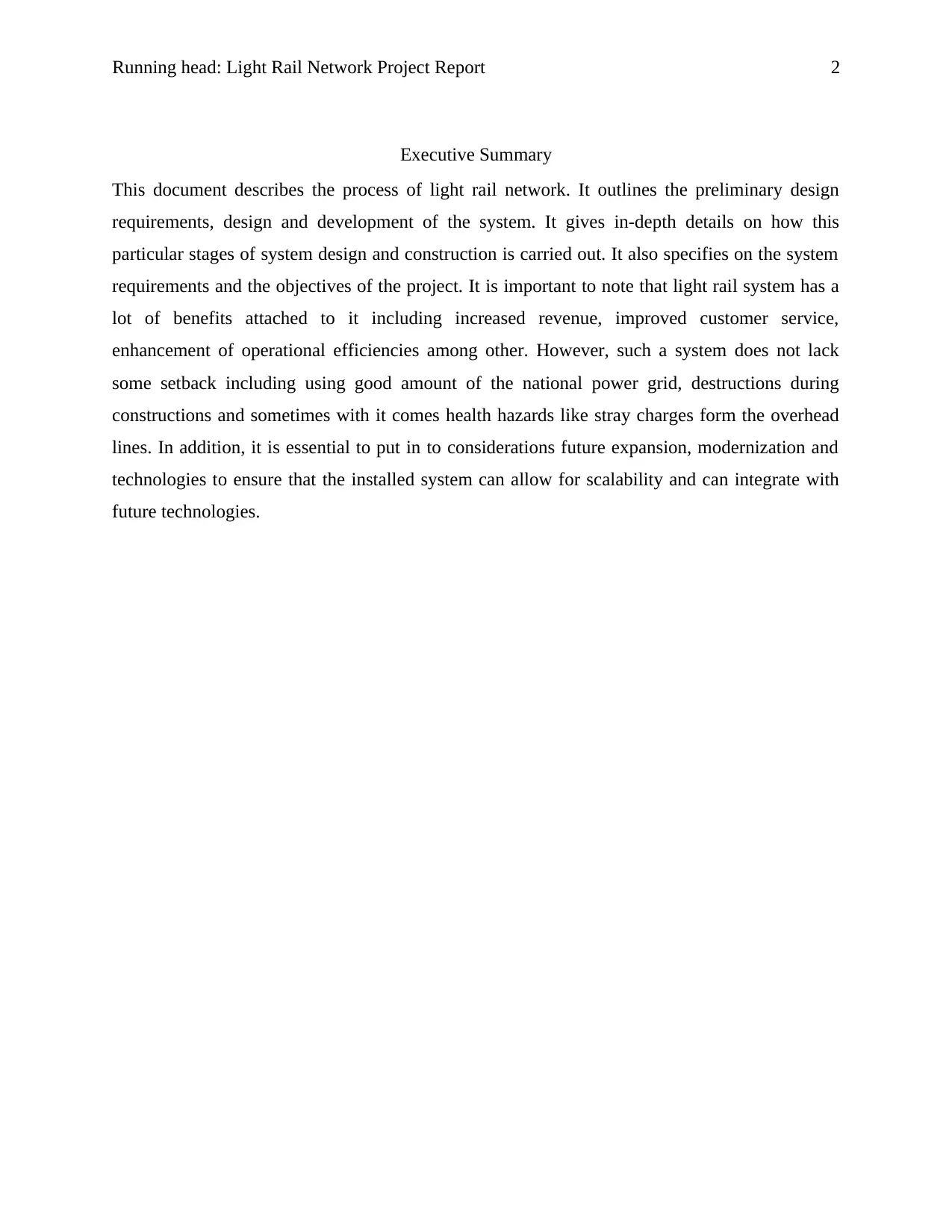
Running head: Light Rail Network Project Report 2
Executive Summary
This document describes the process of light rail network. It outlines the preliminary design
requirements, design and development of the system. It gives in-depth details on how this
particular stages of system design and construction is carried out. It also specifies on the system
requirements and the objectives of the project. It is important to note that light rail system has a
lot of benefits attached to it including increased revenue, improved customer service,
enhancement of operational efficiencies among other. However, such a system does not lack
some setback including using good amount of the national power grid, destructions during
constructions and sometimes with it comes health hazards like stray charges form the overhead
lines. In addition, it is essential to put in to considerations future expansion, modernization and
technologies to ensure that the installed system can allow for scalability and can integrate with
future technologies.
Executive Summary
This document describes the process of light rail network. It outlines the preliminary design
requirements, design and development of the system. It gives in-depth details on how this
particular stages of system design and construction is carried out. It also specifies on the system
requirements and the objectives of the project. It is important to note that light rail system has a
lot of benefits attached to it including increased revenue, improved customer service,
enhancement of operational efficiencies among other. However, such a system does not lack
some setback including using good amount of the national power grid, destructions during
constructions and sometimes with it comes health hazards like stray charges form the overhead
lines. In addition, it is essential to put in to considerations future expansion, modernization and
technologies to ensure that the installed system can allow for scalability and can integrate with
future technologies.
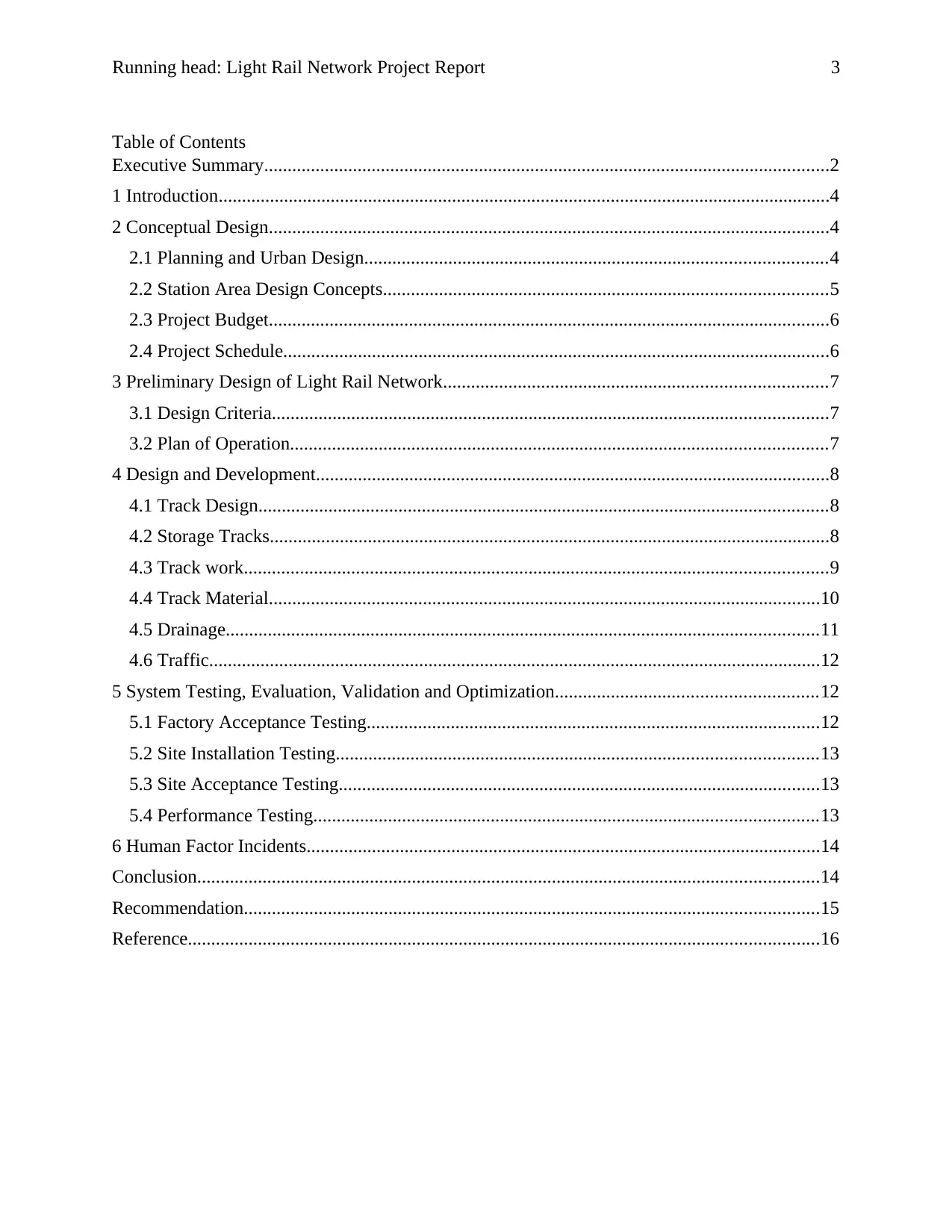
Running head: Light Rail Network Project Report 3
Table of Contents
Executive Summary.........................................................................................................................2
1 Introduction...................................................................................................................................4
2 Conceptual Design........................................................................................................................4
2.1 Planning and Urban Design...................................................................................................4
2.2 Station Area Design Concepts...............................................................................................5
2.3 Project Budget........................................................................................................................6
2.4 Project Schedule.....................................................................................................................6
3 Preliminary Design of Light Rail Network..................................................................................7
3.1 Design Criteria.......................................................................................................................7
3.2 Plan of Operation...................................................................................................................7
4 Design and Development..............................................................................................................8
4.1 Track Design..........................................................................................................................8
4.2 Storage Tracks........................................................................................................................8
4.3 Track work.............................................................................................................................9
4.4 Track Material......................................................................................................................10
4.5 Drainage...............................................................................................................................11
4.6 Traffic...................................................................................................................................12
5 System Testing, Evaluation, Validation and Optimization........................................................12
5.1 Factory Acceptance Testing.................................................................................................12
5.2 Site Installation Testing.......................................................................................................13
5.3 Site Acceptance Testing.......................................................................................................13
5.4 Performance Testing............................................................................................................13
6 Human Factor Incidents..............................................................................................................14
Conclusion.....................................................................................................................................14
Recommendation...........................................................................................................................15
Reference.......................................................................................................................................16
Table of Contents
Executive Summary.........................................................................................................................2
1 Introduction...................................................................................................................................4
2 Conceptual Design........................................................................................................................4
2.1 Planning and Urban Design...................................................................................................4
2.2 Station Area Design Concepts...............................................................................................5
2.3 Project Budget........................................................................................................................6
2.4 Project Schedule.....................................................................................................................6
3 Preliminary Design of Light Rail Network..................................................................................7
3.1 Design Criteria.......................................................................................................................7
3.2 Plan of Operation...................................................................................................................7
4 Design and Development..............................................................................................................8
4.1 Track Design..........................................................................................................................8
4.2 Storage Tracks........................................................................................................................8
4.3 Track work.............................................................................................................................9
4.4 Track Material......................................................................................................................10
4.5 Drainage...............................................................................................................................11
4.6 Traffic...................................................................................................................................12
5 System Testing, Evaluation, Validation and Optimization........................................................12
5.1 Factory Acceptance Testing.................................................................................................12
5.2 Site Installation Testing.......................................................................................................13
5.3 Site Acceptance Testing.......................................................................................................13
5.4 Performance Testing............................................................................................................13
6 Human Factor Incidents..............................................................................................................14
Conclusion.....................................................................................................................................14
Recommendation...........................................................................................................................15
Reference.......................................................................................................................................16
⊘ This is a preview!⊘
Do you want full access?
Subscribe today to unlock all pages.

Trusted by 1+ million students worldwide

Running head: Light Rail Network Project Report 4
1 Introduction
Achieving a successful light rail implementation requires preliminary engineering and critical
planning of the same. It needs a lot of effort dedication, skills and resources. And as they mature
the light rail networks expand and further pushes out of their original point.
2 Conceptual Design
The light rail network project will be developed within the city of Sydney. Due to the rising
population and business enterprise within Sydney, there is need to develop a transport alternative
with effect to these facts. The project requirements will be outlined and summarized and
reviewed by several other parties including the local authorities, contractors and employer.
Regular updates will be made available to all the stake holders in accordance with the
jurisdiction of project interest. Light rail conceptual design is majorly attributed to planning and
urban design, station are designs, project cost and project schedule. (Lesley, 2011)
2.1 Planning and Urban Design
The major objectives of this phase during project development include; creation of high capacity
alternatives for the estates at which the train will pass, accessibility of the train terminals by all
channels of transport including driving, walking or cycling, involvement of the general public on
design matters, station design areas should mirror the aspirations and past history of the
neighboring population, reduction of interruptions to the adjacent population through critical
evaluation and planning, construction of beautiful station locations, adjusting wherever possible
the right of way, restructuring adjacent structures if necessary appropriately, and promotion of
sustainability objectives of the society. (Currie & Burke, 2013).
1 Introduction
Achieving a successful light rail implementation requires preliminary engineering and critical
planning of the same. It needs a lot of effort dedication, skills and resources. And as they mature
the light rail networks expand and further pushes out of their original point.
2 Conceptual Design
The light rail network project will be developed within the city of Sydney. Due to the rising
population and business enterprise within Sydney, there is need to develop a transport alternative
with effect to these facts. The project requirements will be outlined and summarized and
reviewed by several other parties including the local authorities, contractors and employer.
Regular updates will be made available to all the stake holders in accordance with the
jurisdiction of project interest. Light rail conceptual design is majorly attributed to planning and
urban design, station are designs, project cost and project schedule. (Lesley, 2011)
2.1 Planning and Urban Design
The major objectives of this phase during project development include; creation of high capacity
alternatives for the estates at which the train will pass, accessibility of the train terminals by all
channels of transport including driving, walking or cycling, involvement of the general public on
design matters, station design areas should mirror the aspirations and past history of the
neighboring population, reduction of interruptions to the adjacent population through critical
evaluation and planning, construction of beautiful station locations, adjusting wherever possible
the right of way, restructuring adjacent structures if necessary appropriately, and promotion of
sustainability objectives of the society. (Currie & Burke, 2013).
Paraphrase This Document
Need a fresh take? Get an instant paraphrase of this document with our AI Paraphraser
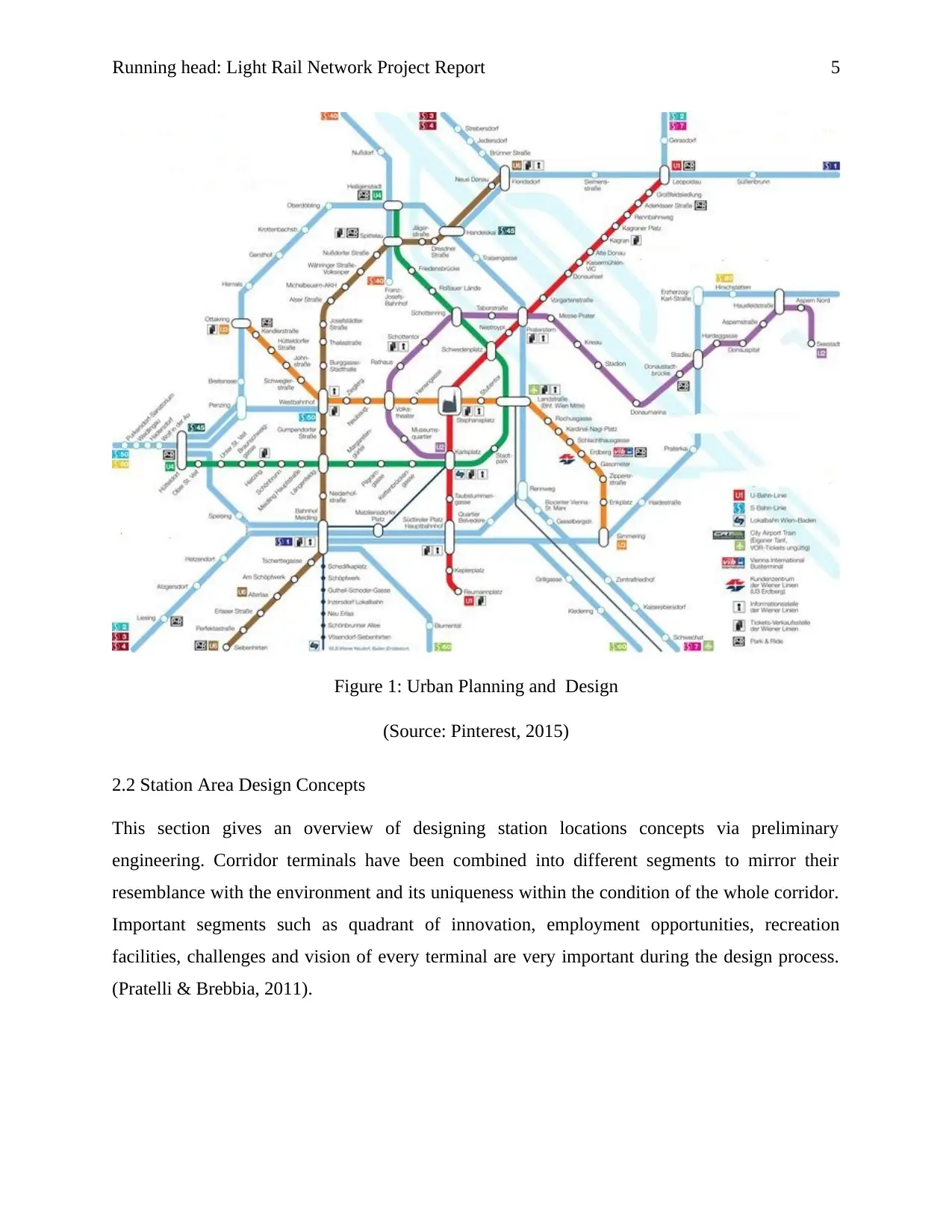
Running head: Light Rail Network Project Report 5
Figure 1: Urban Planning and Design
(Source: Pinterest, 2015)
2.2 Station Area Design Concepts
This section gives an overview of designing station locations concepts via preliminary
engineering. Corridor terminals have been combined into different segments to mirror their
resemblance with the environment and its uniqueness within the condition of the whole corridor.
Important segments such as quadrant of innovation, employment opportunities, recreation
facilities, challenges and vision of every terminal are very important during the design process.
(Pratelli & Brebbia, 2011).
Figure 1: Urban Planning and Design
(Source: Pinterest, 2015)
2.2 Station Area Design Concepts
This section gives an overview of designing station locations concepts via preliminary
engineering. Corridor terminals have been combined into different segments to mirror their
resemblance with the environment and its uniqueness within the condition of the whole corridor.
Important segments such as quadrant of innovation, employment opportunities, recreation
facilities, challenges and vision of every terminal are very important during the design process.
(Pratelli & Brebbia, 2011).
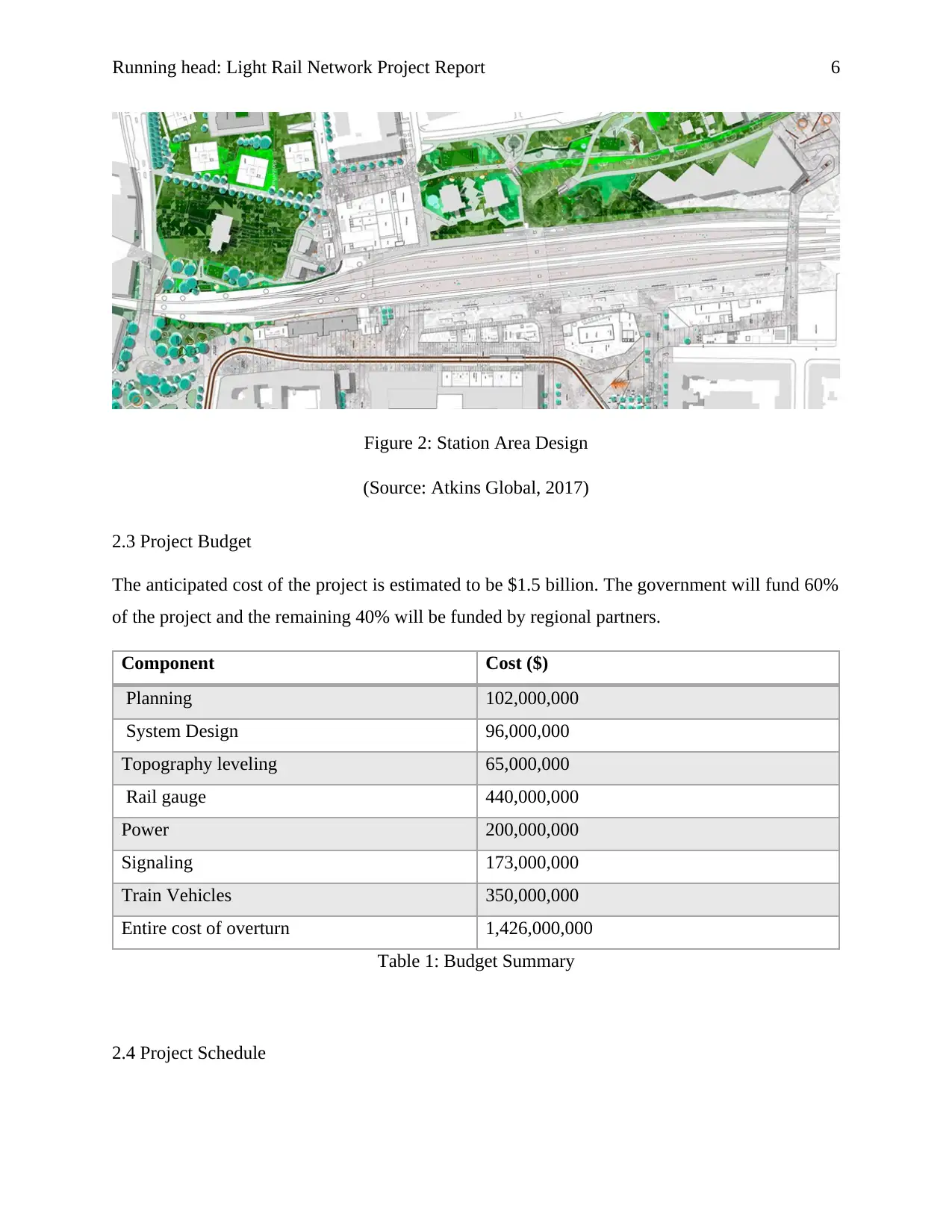
Running head: Light Rail Network Project Report 6
Figure 2: Station Area Design
(Source: Atkins Global, 2017)
2.3 Project Budget
The anticipated cost of the project is estimated to be $1.5 billion. The government will fund 60%
of the project and the remaining 40% will be funded by regional partners.
Component Cost ($)
Planning 102,000,000
System Design 96,000,000
Topography leveling 65,000,000
Rail gauge 440,000,000
Power 200,000,000
Signaling 173,000,000
Train Vehicles 350,000,000
Entire cost of overturn 1,426,000,000
Table 1: Budget Summary
2.4 Project Schedule
Figure 2: Station Area Design
(Source: Atkins Global, 2017)
2.3 Project Budget
The anticipated cost of the project is estimated to be $1.5 billion. The government will fund 60%
of the project and the remaining 40% will be funded by regional partners.
Component Cost ($)
Planning 102,000,000
System Design 96,000,000
Topography leveling 65,000,000
Rail gauge 440,000,000
Power 200,000,000
Signaling 173,000,000
Train Vehicles 350,000,000
Entire cost of overturn 1,426,000,000
Table 1: Budget Summary
2.4 Project Schedule
⊘ This is a preview!⊘
Do you want full access?
Subscribe today to unlock all pages.

Trusted by 1+ million students worldwide
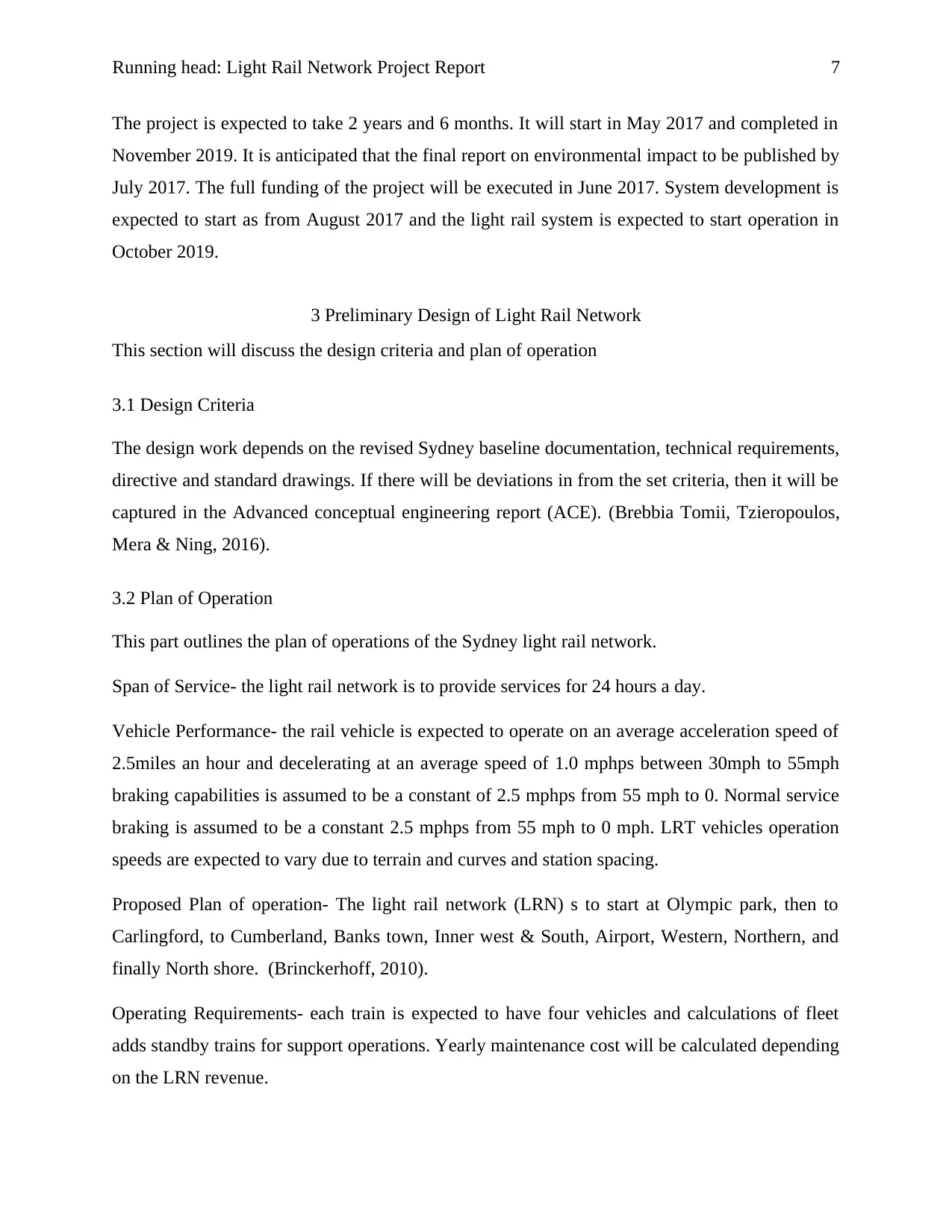
Running head: Light Rail Network Project Report 7
The project is expected to take 2 years and 6 months. It will start in May 2017 and completed in
November 2019. It is anticipated that the final report on environmental impact to be published by
July 2017. The full funding of the project will be executed in June 2017. System development is
expected to start as from August 2017 and the light rail system is expected to start operation in
October 2019.
3 Preliminary Design of Light Rail Network
This section will discuss the design criteria and plan of operation
3.1 Design Criteria
The design work depends on the revised Sydney baseline documentation, technical requirements,
directive and standard drawings. If there will be deviations in from the set criteria, then it will be
captured in the Advanced conceptual engineering report (ACE). (Brebbia Tomii, Tzieropoulos,
Mera & Ning, 2016).
3.2 Plan of Operation
This part outlines the plan of operations of the Sydney light rail network.
Span of Service- the light rail network is to provide services for 24 hours a day.
Vehicle Performance- the rail vehicle is expected to operate on an average acceleration speed of
2.5miles an hour and decelerating at an average speed of 1.0 mphps between 30mph to 55mph
braking capabilities is assumed to be a constant of 2.5 mphps from 55 mph to 0. Normal service
braking is assumed to be a constant 2.5 mphps from 55 mph to 0 mph. LRT vehicles operation
speeds are expected to vary due to terrain and curves and station spacing.
Proposed Plan of operation- The light rail network (LRN) s to start at Olympic park, then to
Carlingford, to Cumberland, Banks town, Inner west & South, Airport, Western, Northern, and
finally North shore. (Brinckerhoff, 2010).
Operating Requirements- each train is expected to have four vehicles and calculations of fleet
adds standby trains for support operations. Yearly maintenance cost will be calculated depending
on the LRN revenue.
The project is expected to take 2 years and 6 months. It will start in May 2017 and completed in
November 2019. It is anticipated that the final report on environmental impact to be published by
July 2017. The full funding of the project will be executed in June 2017. System development is
expected to start as from August 2017 and the light rail system is expected to start operation in
October 2019.
3 Preliminary Design of Light Rail Network
This section will discuss the design criteria and plan of operation
3.1 Design Criteria
The design work depends on the revised Sydney baseline documentation, technical requirements,
directive and standard drawings. If there will be deviations in from the set criteria, then it will be
captured in the Advanced conceptual engineering report (ACE). (Brebbia Tomii, Tzieropoulos,
Mera & Ning, 2016).
3.2 Plan of Operation
This part outlines the plan of operations of the Sydney light rail network.
Span of Service- the light rail network is to provide services for 24 hours a day.
Vehicle Performance- the rail vehicle is expected to operate on an average acceleration speed of
2.5miles an hour and decelerating at an average speed of 1.0 mphps between 30mph to 55mph
braking capabilities is assumed to be a constant of 2.5 mphps from 55 mph to 0. Normal service
braking is assumed to be a constant 2.5 mphps from 55 mph to 0 mph. LRT vehicles operation
speeds are expected to vary due to terrain and curves and station spacing.
Proposed Plan of operation- The light rail network (LRN) s to start at Olympic park, then to
Carlingford, to Cumberland, Banks town, Inner west & South, Airport, Western, Northern, and
finally North shore. (Brinckerhoff, 2010).
Operating Requirements- each train is expected to have four vehicles and calculations of fleet
adds standby trains for support operations. Yearly maintenance cost will be calculated depending
on the LRN revenue.
Paraphrase This Document
Need a fresh take? Get an instant paraphrase of this document with our AI Paraphraser

Running head: Light Rail Network Project Report 8
4 Design and Development
This section will discuss the actual design and construction of the light rail components and
structures including track design, track works, drainage systems among others.
4.1 Track Design
Alignment of track starts Olympic park to the existing Carlingford terminal. Then the track
would run until Cumberland on a raised rail then turn to Banks town and continue to Inner west
& South. The track alignment would proceed Airport then to Western, Northern, and finally
North shore. (Ning, 2010).
Horizontal Alignment- this alignment will be made up of two models, that is, curves and
tangents. Spiral transitions will connect tangents to curves. Operational design speed will control
both horizontal curves and spiral transitions.
Vertical Alignment- this is the elevation of the lowest part of the rail. Connected by vertical
curves which are parabolic. The minimum requirement for tunnels is 10 feet above the highest
point in a private property. (Parsons, Quade & Douglas, 2012).
Figure 3: Track Design
(Source: Bridgette Meinhold, 2014)
4.2 Storage Tracks
4 Design and Development
This section will discuss the actual design and construction of the light rail components and
structures including track design, track works, drainage systems among others.
4.1 Track Design
Alignment of track starts Olympic park to the existing Carlingford terminal. Then the track
would run until Cumberland on a raised rail then turn to Banks town and continue to Inner west
& South. The track alignment would proceed Airport then to Western, Northern, and finally
North shore. (Ning, 2010).
Horizontal Alignment- this alignment will be made up of two models, that is, curves and
tangents. Spiral transitions will connect tangents to curves. Operational design speed will control
both horizontal curves and spiral transitions.
Vertical Alignment- this is the elevation of the lowest part of the rail. Connected by vertical
curves which are parabolic. The minimum requirement for tunnels is 10 feet above the highest
point in a private property. (Parsons, Quade & Douglas, 2012).
Figure 3: Track Design
(Source: Bridgette Meinhold, 2014)
4.2 Storage Tracks

Running head: Light Rail Network Project Report 9
This is part of the yard for maintenance which is constructed during the construction of rail line.
The storage tracks would provide an avenue for cleaning the train vehicles, tuning of wheels,
part replacement and hoist area. (Lesley, 2011).
Figure 4: Storage Track Design
(Source: Julie Oliver, 2016)
4.3 Track work
Direct Fixation Track
The primary construction of light rail is direct fixation. This is utilized in underground sections
and aerial alignments and would include direct fixation of assembly of rail fastening and fastener
pads. The rails fasteners pads would be attached to the second pour segment with concrete
reinforcement of roughly 27 inches wide and 20 feet long. A 6-inch gap will be offered by laying
out drainage plinth pads. Additional drainage would be provided by the holes underneath plinth
This is part of the yard for maintenance which is constructed during the construction of rail line.
The storage tracks would provide an avenue for cleaning the train vehicles, tuning of wheels,
part replacement and hoist area. (Lesley, 2011).
Figure 4: Storage Track Design
(Source: Julie Oliver, 2016)
4.3 Track work
Direct Fixation Track
The primary construction of light rail is direct fixation. This is utilized in underground sections
and aerial alignments and would include direct fixation of assembly of rail fastening and fastener
pads. The rails fasteners pads would be attached to the second pour segment with concrete
reinforcement of roughly 27 inches wide and 20 feet long. A 6-inch gap will be offered by laying
out drainage plinth pads. Additional drainage would be provided by the holes underneath plinth
⊘ This is a preview!⊘
Do you want full access?
Subscribe today to unlock all pages.

Trusted by 1+ million students worldwide
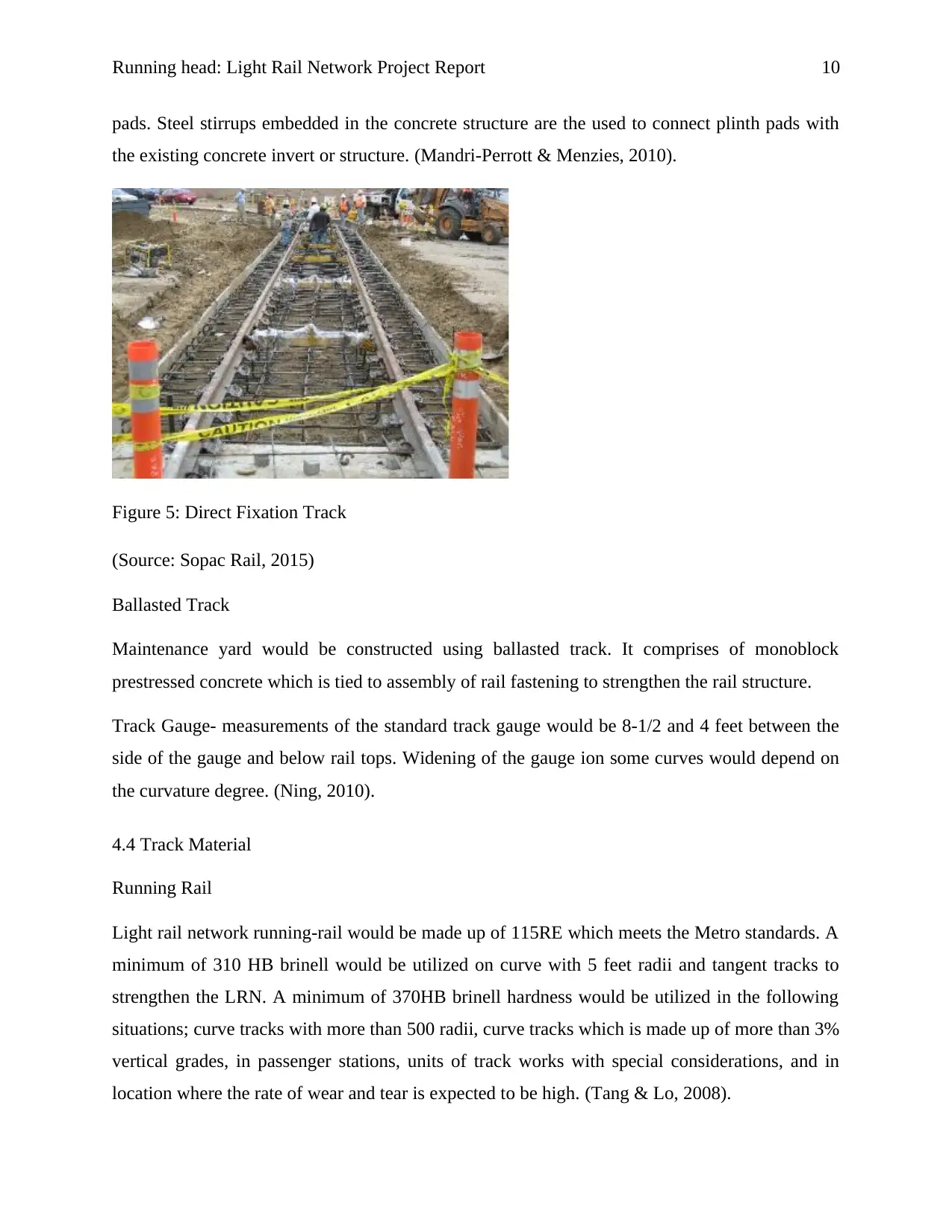
Running head: Light Rail Network Project Report 10
pads. Steel stirrups embedded in the concrete structure are the used to connect plinth pads with
the existing concrete invert or structure. (Mandri-Perrott & Menzies, 2010).
Figure 5: Direct Fixation Track
(Source: Sopac Rail, 2015)
Ballasted Track
Maintenance yard would be constructed using ballasted track. It comprises of monoblock
prestressed concrete which is tied to assembly of rail fastening to strengthen the rail structure.
Track Gauge- measurements of the standard track gauge would be 8-1/2 and 4 feet between the
side of the gauge and below rail tops. Widening of the gauge ion some curves would depend on
the curvature degree. (Ning, 2010).
4.4 Track Material
Running Rail
Light rail network running-rail would be made up of 115RE which meets the Metro standards. A
minimum of 310 HB brinell would be utilized on curve with 5 feet radii and tangent tracks to
strengthen the LRN. A minimum of 370HB brinell hardness would be utilized in the following
situations; curve tracks with more than 500 radii, curve tracks which is made up of more than 3%
vertical grades, in passenger stations, units of track works with special considerations, and in
location where the rate of wear and tear is expected to be high. (Tang & Lo, 2008).
pads. Steel stirrups embedded in the concrete structure are the used to connect plinth pads with
the existing concrete invert or structure. (Mandri-Perrott & Menzies, 2010).
Figure 5: Direct Fixation Track
(Source: Sopac Rail, 2015)
Ballasted Track
Maintenance yard would be constructed using ballasted track. It comprises of monoblock
prestressed concrete which is tied to assembly of rail fastening to strengthen the rail structure.
Track Gauge- measurements of the standard track gauge would be 8-1/2 and 4 feet between the
side of the gauge and below rail tops. Widening of the gauge ion some curves would depend on
the curvature degree. (Ning, 2010).
4.4 Track Material
Running Rail
Light rail network running-rail would be made up of 115RE which meets the Metro standards. A
minimum of 310 HB brinell would be utilized on curve with 5 feet radii and tangent tracks to
strengthen the LRN. A minimum of 370HB brinell hardness would be utilized in the following
situations; curve tracks with more than 500 radii, curve tracks which is made up of more than 3%
vertical grades, in passenger stations, units of track works with special considerations, and in
location where the rate of wear and tear is expected to be high. (Tang & Lo, 2008).
Paraphrase This Document
Need a fresh take? Get an instant paraphrase of this document with our AI Paraphraser
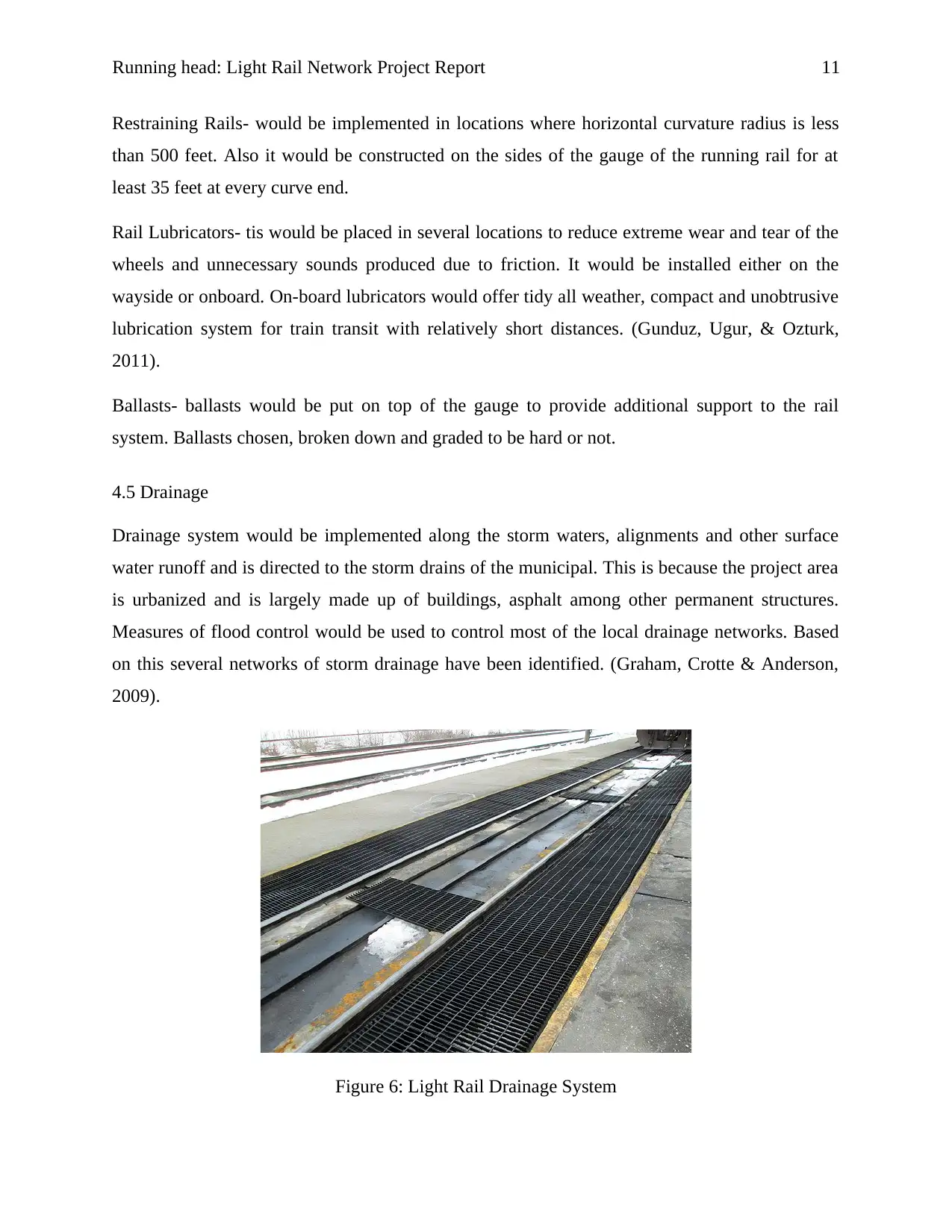
Running head: Light Rail Network Project Report 11
Restraining Rails- would be implemented in locations where horizontal curvature radius is less
than 500 feet. Also it would be constructed on the sides of the gauge of the running rail for at
least 35 feet at every curve end.
Rail Lubricators- tis would be placed in several locations to reduce extreme wear and tear of the
wheels and unnecessary sounds produced due to friction. It would be installed either on the
wayside or onboard. On-board lubricators would offer tidy all weather, compact and unobtrusive
lubrication system for train transit with relatively short distances. (Gunduz, Ugur, & Ozturk,
2011).
Ballasts- ballasts would be put on top of the gauge to provide additional support to the rail
system. Ballasts chosen, broken down and graded to be hard or not.
4.5 Drainage
Drainage system would be implemented along the storm waters, alignments and other surface
water runoff and is directed to the storm drains of the municipal. This is because the project area
is urbanized and is largely made up of buildings, asphalt among other permanent structures.
Measures of flood control would be used to control most of the local drainage networks. Based
on this several networks of storm drainage have been identified. (Graham, Crotte & Anderson,
2009).
Figure 6: Light Rail Drainage System
Restraining Rails- would be implemented in locations where horizontal curvature radius is less
than 500 feet. Also it would be constructed on the sides of the gauge of the running rail for at
least 35 feet at every curve end.
Rail Lubricators- tis would be placed in several locations to reduce extreme wear and tear of the
wheels and unnecessary sounds produced due to friction. It would be installed either on the
wayside or onboard. On-board lubricators would offer tidy all weather, compact and unobtrusive
lubrication system for train transit with relatively short distances. (Gunduz, Ugur, & Ozturk,
2011).
Ballasts- ballasts would be put on top of the gauge to provide additional support to the rail
system. Ballasts chosen, broken down and graded to be hard or not.
4.5 Drainage
Drainage system would be implemented along the storm waters, alignments and other surface
water runoff and is directed to the storm drains of the municipal. This is because the project area
is urbanized and is largely made up of buildings, asphalt among other permanent structures.
Measures of flood control would be used to control most of the local drainage networks. Based
on this several networks of storm drainage have been identified. (Graham, Crotte & Anderson,
2009).
Figure 6: Light Rail Drainage System
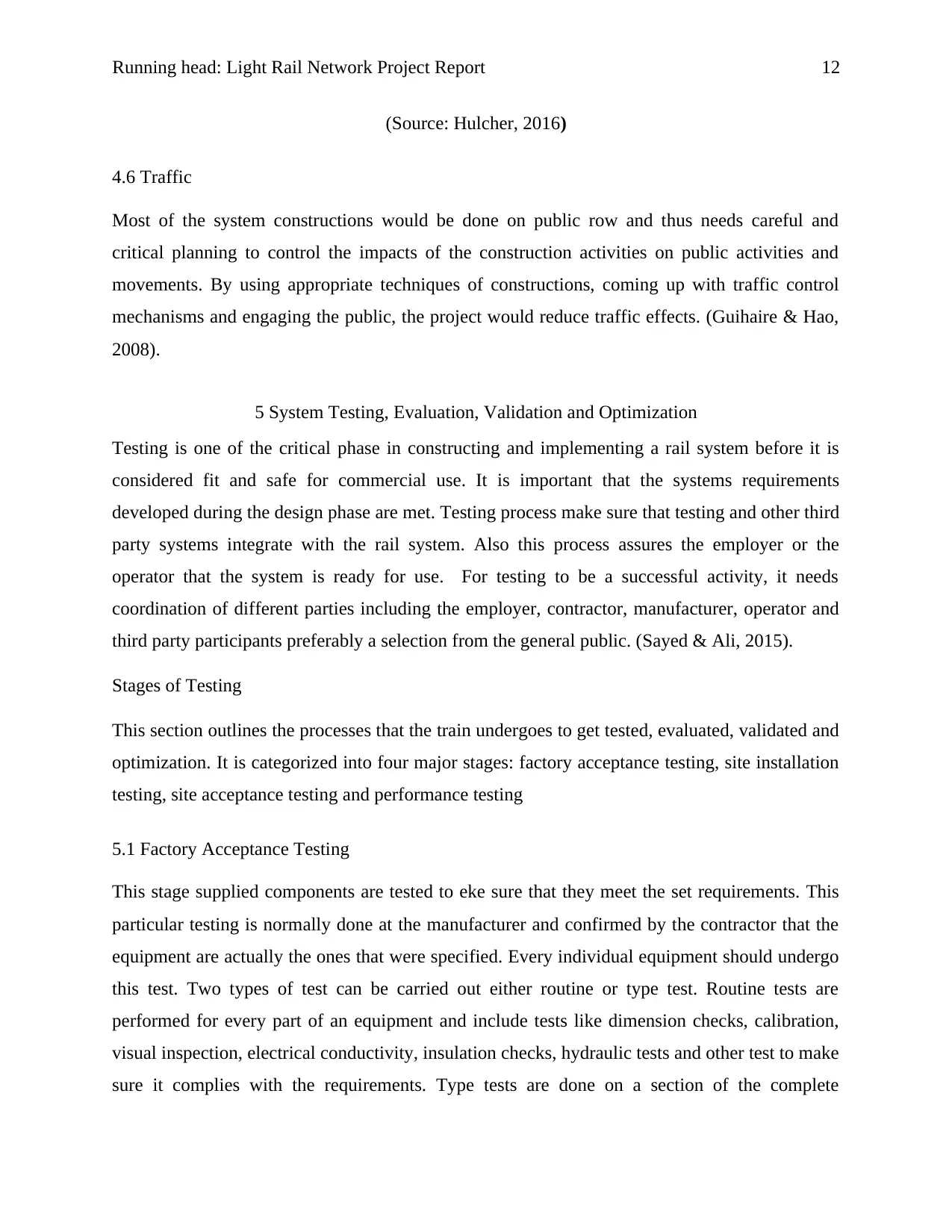
Running head: Light Rail Network Project Report 12
(Source: Hulcher, 2016)
4.6 Traffic
Most of the system constructions would be done on public row and thus needs careful and
critical planning to control the impacts of the construction activities on public activities and
movements. By using appropriate techniques of constructions, coming up with traffic control
mechanisms and engaging the public, the project would reduce traffic effects. (Guihaire & Hao,
2008).
5 System Testing, Evaluation, Validation and Optimization
Testing is one of the critical phase in constructing and implementing a rail system before it is
considered fit and safe for commercial use. It is important that the systems requirements
developed during the design phase are met. Testing process make sure that testing and other third
party systems integrate with the rail system. Also this process assures the employer or the
operator that the system is ready for use. For testing to be a successful activity, it needs
coordination of different parties including the employer, contractor, manufacturer, operator and
third party participants preferably a selection from the general public. (Sayed & Ali, 2015).
Stages of Testing
This section outlines the processes that the train undergoes to get tested, evaluated, validated and
optimization. It is categorized into four major stages: factory acceptance testing, site installation
testing, site acceptance testing and performance testing
5.1 Factory Acceptance Testing
This stage supplied components are tested to eke sure that they meet the set requirements. This
particular testing is normally done at the manufacturer and confirmed by the contractor that the
equipment are actually the ones that were specified. Every individual equipment should undergo
this test. Two types of test can be carried out either routine or type test. Routine tests are
performed for every part of an equipment and include tests like dimension checks, calibration,
visual inspection, electrical conductivity, insulation checks, hydraulic tests and other test to make
sure it complies with the requirements. Type tests are done on a section of the complete
(Source: Hulcher, 2016)
4.6 Traffic
Most of the system constructions would be done on public row and thus needs careful and
critical planning to control the impacts of the construction activities on public activities and
movements. By using appropriate techniques of constructions, coming up with traffic control
mechanisms and engaging the public, the project would reduce traffic effects. (Guihaire & Hao,
2008).
5 System Testing, Evaluation, Validation and Optimization
Testing is one of the critical phase in constructing and implementing a rail system before it is
considered fit and safe for commercial use. It is important that the systems requirements
developed during the design phase are met. Testing process make sure that testing and other third
party systems integrate with the rail system. Also this process assures the employer or the
operator that the system is ready for use. For testing to be a successful activity, it needs
coordination of different parties including the employer, contractor, manufacturer, operator and
third party participants preferably a selection from the general public. (Sayed & Ali, 2015).
Stages of Testing
This section outlines the processes that the train undergoes to get tested, evaluated, validated and
optimization. It is categorized into four major stages: factory acceptance testing, site installation
testing, site acceptance testing and performance testing
5.1 Factory Acceptance Testing
This stage supplied components are tested to eke sure that they meet the set requirements. This
particular testing is normally done at the manufacturer and confirmed by the contractor that the
equipment are actually the ones that were specified. Every individual equipment should undergo
this test. Two types of test can be carried out either routine or type test. Routine tests are
performed for every part of an equipment and include tests like dimension checks, calibration,
visual inspection, electrical conductivity, insulation checks, hydraulic tests and other test to make
sure it complies with the requirements. Type tests are done on a section of the complete
⊘ This is a preview!⊘
Do you want full access?
Subscribe today to unlock all pages.

Trusted by 1+ million students worldwide
1 out of 17
Related Documents
Your All-in-One AI-Powered Toolkit for Academic Success.
+13062052269
info@desklib.com
Available 24*7 on WhatsApp / Email
![[object Object]](/_next/static/media/star-bottom.7253800d.svg)
Unlock your academic potential
Copyright © 2020–2025 A2Z Services. All Rights Reserved. Developed and managed by ZUCOL.





